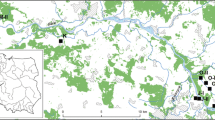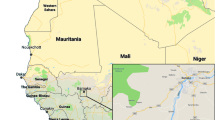Abstract
The moth,Pterolonche inspersa (Staudinger) (Lepidoptera: Pterolonchidae), is widely distributed in southern Europe, north Africa, Turkey and the former Soviet Union. It occurs in both thick and scattered stands of knapweeds in disturbed sites, usually on sandy and/or stony soil. Larvae bore in the roots of diffuse and spotted knapweeds (Centaurea diffusa De Lamarck andC. maculosa De Lamarck). There is one generation per year in northern Greece, and larvae feed in the roots for about 11 months during the growing season (August–September, to the following July–August). In the laboratory garden, emergence took place between the second half of July and the end of August, with peak emergence during mid August. In the field, adults were observed from early to late July. Female moths oviposited on rosettes during the first ten days of July and continued through the end of July. Eggs were laid singly or in groups of five or six, firmly attached to the leaves of the host plant. In the laboratory, females mated within 24 hours of emergence and the preoviposition period lasted 2.6±0.8 days. The oviposition period lasted 7.4±2.2 days and the average number of eggs per female was 142.2±59.2. The incubation period was 12±4.7 days; the pupal stage lasted 14.7±2.4 days; and females lived 15.8±2.4 days, while males lived 10.7±1.4 days. First instar larvae failed to survive on economically important Compositae in the generaCynara L.,Helianthus L.,Zinnia L. andCalendula L. (Dunnet al., 1989).
Résumé
La biologie de la PhalènePterolonche inspersa (Staudinger) (Lepidoptera: Pterolonchidae) a été étudiée dans le Sud de l'Europe. Les larves vivent dans les racines deCentaurea diffusa De Lamarck et deC. maculosa De Lamarck. Les larves de premier stade n'infestent pas les Compositae d'importance économique des genresCynara L.,Helianthus L.,Zinnia L. etCalendula L.P. inspersa est largement répandue dans la zone étudiée, et se retrouve à la fois dans des populations denses ou dispersées de la plante hôte, en général sur des sols sableux ou rocheux. Il n'existe qu'une seule génération par an. Les larves se nourrissent dans les racines pendant environ 11 mois (août–septembre à juillet–août de l'année suivante). Au laboratoire, les adultes émergent entre mi-juillet et fin août, le pic d'émergence se situant à la mi-août. Sur le terrain, les adultes sont observés tout au long du mois de juillet. L'oviposition a été observée à partir du 10 juillet jusqu'à la fin du mois. Les œufs sont déposés isolément ou en groupes de 5 ou 6 sur des rosettes, solidement fixés aux feuilles des plantes-hôtes.
Au laboratoire, les adultes s'accouplent au cours des 24 heures suivant l'émergence. La période de pré-oviposition dure 2,6±0,8 jours et la période de l'oviposition 7,4±2,2 jours. Le nombre moyen d'œufs pondus est de 142,2±59,2 par femelle. La durée moyenne d'incubation est de 12±4,7 jours, le stade durant 14,7±2,4 jours. La durée de vie des femelles est supérieure à celle des mâles: 15,8±2,4 au lieu de 10,7±1,4 jours.
Similar content being viewed by others
References
Dunn, P. H., Rosenthal, S. S., Campobasso, G. &Tait, S. M. — 1989. Host specificity ofPterolonche inspersa (Lep.: Pterolonchidae) and its potential as a biological control agent forCentaurea diffusa, diffuse knapweed, andC. maculosa, spotted knapweed. —Entomophaga, 34, 31–42.
Lacey, C. — 1989. Knapweed management, a decade of change. Pp. 1–6.In:Peter K. Fay, John R. Lacey, (eds). Proc. Knapweed Symp., Bozeman, MT, USA. Apr. 4–5, 1989. Plant and Soil Science Department and Extension Service, Montana State University.
Maddox, D. M. — 1979. The Knapweeds: Their Economics and Biological Control in the Western States. U. S. A. Rangeland., 1, 139–141.
Moreno, A. V. — 1984.Pterolonche gozmaniella Vives nov. sp., nueva especie de la familia Pterolonchidae Meyrick, 1918, para la fauna de España.Shilap Revta. Lepid., 12, 195–197.
Müller, H. — 1984. Die Strukturanalyse des Wurzel-Phytophagenkomplex vonCentaurea maculosa Lam. undC. diffusa Lam. (Compositae) in Europa und Interaktion zwischen wichtigen Phytophagenarten und ihren Wirtsplanzen. Ph.D. Thesis, Universität Bern, 163 pp.
Rosenthal, S. S., Campobasso, G., Fornasari, L., Sobhian, R. &Turner, C. E. —1992. Biological control ofCentaurea spp. Pp. 292–302.In: Noxious Range weeds, (L. F. James et al. (eds.)) Westview Press, Boulder, San Francisco, and Oxford.
Schroeder, D. — 1977. Biotic agents attacking diffuse knapweed and spotted knapweed in Europe and their prospective suitability for biological control in North America. — Proc. Knapweed Symp., Kamloops, B. C., Canada, Oct. 6–7, 1977 — British Columbia Ministr Agric., Victoria, B. C. V8W-227.
Schroeder, D. — 1985. The search for effective biological control agents in Europe. I. Diffuse and spotted knapweed. Pp. 103–119.In E. S. Delfosse, (ed.) Proc. VI —Int. Symp. Biol. Contr. Weeds, 14–25 Aug. 1984, Vancouver, Canada. Agric. Canada.
Watson, A. K. &Renny, A. J. — 1974. The biology of Canadian weeds:Centaurea diffusa andCentaurea maculosa. —Can. Jour., Plant. Sci., 54, 687–701.
Author information
Authors and Affiliations
Rights and permissions
About this article
Cite this article
Campobasso, G., Sobhian, R., Knutson, L. et al. Biology ofPterolonche inspersa (Lep.: Pterolonchidae), a biological control agent forCentaurea diffusa andC. maculosa in the United States. Entomophaga 39, 377–384 (1994). https://doi.org/10.1007/BF02373043
Received:
Accepted:
Issue Date:
DOI: https://doi.org/10.1007/BF02373043




